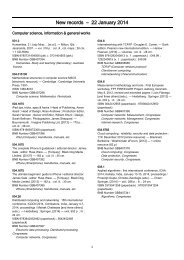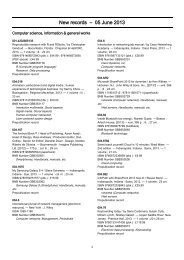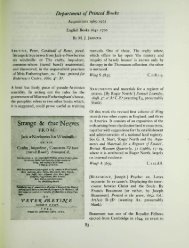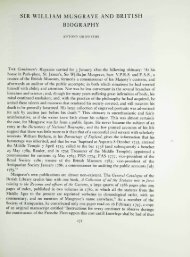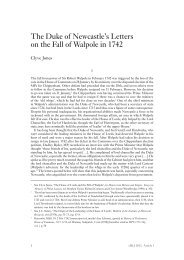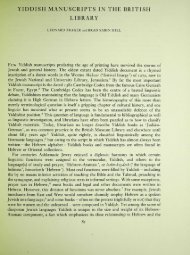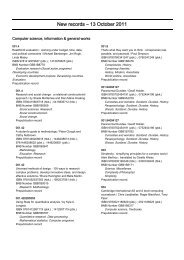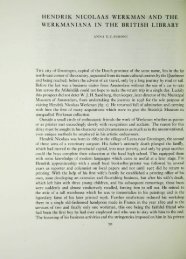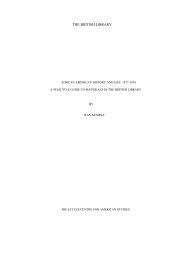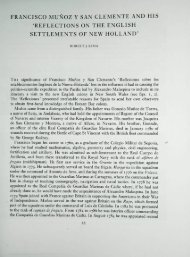A Medieval Psalter 'Perfected': Eighteenth-Century ... - British Library
A Medieval Psalter 'Perfected': Eighteenth-Century ... - British Library
A Medieval Psalter 'Perfected': Eighteenth-Century ... - British Library
You also want an ePaper? Increase the reach of your titles
YUMPU automatically turns print PDFs into web optimized ePapers that Google loves.
A <strong>Medieval</strong> <strong>Psalter</strong> ‘Perfected’: <strong>Eighteenth</strong>-<strong>Century</strong> Conservationism and an Early (Female) Restorer<br />
of Rare Books and Manuscripts<br />
The Coverdale Bible<br />
Although differing from techniques that prevail today, Denyer’s practices are recognizable<br />
as conservationist in two respects: first, through regeneration of missing components; and<br />
second, through documentation of her work. In what appears to be her earliest large-scale<br />
project, Denyer cleaved closely to the original artefact, a second edition Coverdale Bible<br />
with several missing or damaged pages. The three final leaves of this large printed book<br />
are replacements with re-copied text and hand-drawn renderings of the original woodcut<br />
images, all by Denyer. An opening that juxtaposes the first replacement page with the original<br />
that faces it shows Denyer’s copy to be an effort at facsimile reproduction that is nevertheless<br />
unconvincing (fig. 6). A hand, not a press, clearly produced these words, which materialize<br />
in thin, irregular and tentative strokes. Furthermore, an intact copy of the same book tracks<br />
Denyer’s improvement as she progressed through the page (fig. 7): whereas the words in the<br />
first paragraph do not match the spacing and lineation in the printed original, the words in<br />
the following paragraphs do (with the exception of two lines). Denyer referred to her labour<br />
in the preliminary note quoted above as ‘a first essay’, and the results recommend that we<br />
take her at her word.<br />
Yet for all its deficiencies, any attempt at all at verisimilitude marks Denyer’s programme<br />
as conservationist. The work carried out in the book does not just compensate for the loss<br />
of textual content. In addition to matching the aspect of the type, Denyer replicated the<br />
book’s bibliographic code, preserving its paratexts and retaining its images. Each of the<br />
five woodcut illustrations on the final three pages of this edition of the Coverdale Bible<br />
is reinstated on the missing leaves, committed to the page in a free-hand reiteration of<br />
the original. The illustration to Revelation 18, for example, both recaptures the subject of<br />
the original woodcut and assimilates in penwork the imprecisions peculiar to that medium<br />
(figs 8 and 9): delineation summarizes rather than specifies, hatchwork alludes to shadow<br />
without modelling it, and a chaos of pen-strokes replaces cautious detail. In other words, the<br />
results of a sixteenth-century woodcut pass with minimal filtration through an eighteenthcentury<br />
pen. While these facsimile pages are not technically proficient, the operating<br />
principles behind them betray an intelligence about the historicity and uniqueness of a given<br />
medium and the value of simulating its aspect. As a piece of juvenilia, this restored Coverdale<br />
Bible reveals much about the origins of Denyer’s conservationist methodology, sensitive to<br />
the historical character of both form and content. One question that this example raises,<br />
for which an answer may never be forthcoming, regards the model Denyer used for the<br />
replacement pages: did she re-copy damaged ones from the original book, or did she seek out<br />
a perfect copy from which to draw her new designs? If the latter, then there is an element of<br />
academic rigour in Denyer’s work that surpasses practicality.<br />
The Denyer <strong>Psalter</strong> restored<br />
Ten years later, Denyer both improved as a facsimilist and departed from her initial adherence<br />
to replication. In the <strong>Psalter</strong> that was given to Denyer by Joseph Parker, she supplied a<br />
parchment replacement for every damaged leaf and appears to have preserved as much of<br />
the material original to the manuscript as possible. A single mutilated page attached to a stub<br />
and bound back into the manuscript sits atop its replacement and records the vandalism that<br />
preceded Denyer’s work (fig. 10). On the new folios, she copied out the text in imitation of<br />
the original scribal hand. An opening that juxtaposes a fifteenth-century page with Denyer’s<br />
eighteenth-century replacement showcases the success of her simulation. Similarly, both her<br />
pen-flourished initials at the start of new verses and champ initials reproduce the medieval<br />
flourishing and illumination to a high degree of fidelity. One of the more historicist aspects<br />
29<br />
I am grateful to Elizabeth Perkins for discussing with me Denyer’s techniques in this volume and for the idea<br />
of filtration.<br />
11<br />
eBLJ 2013, Article 3



